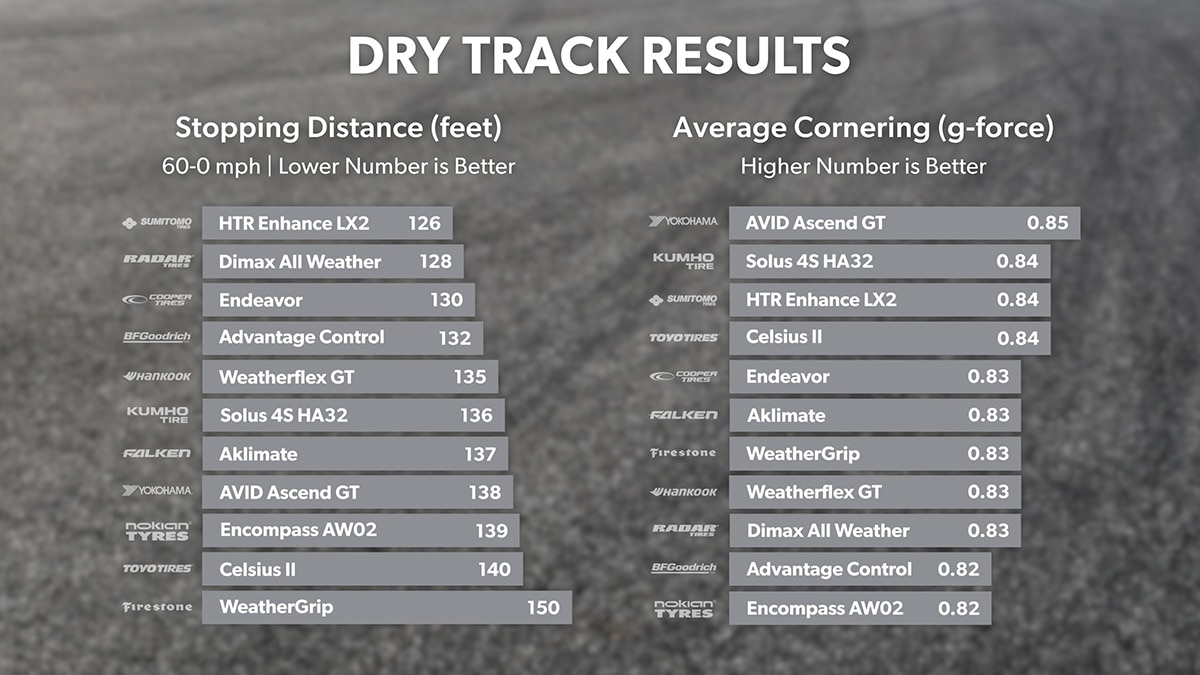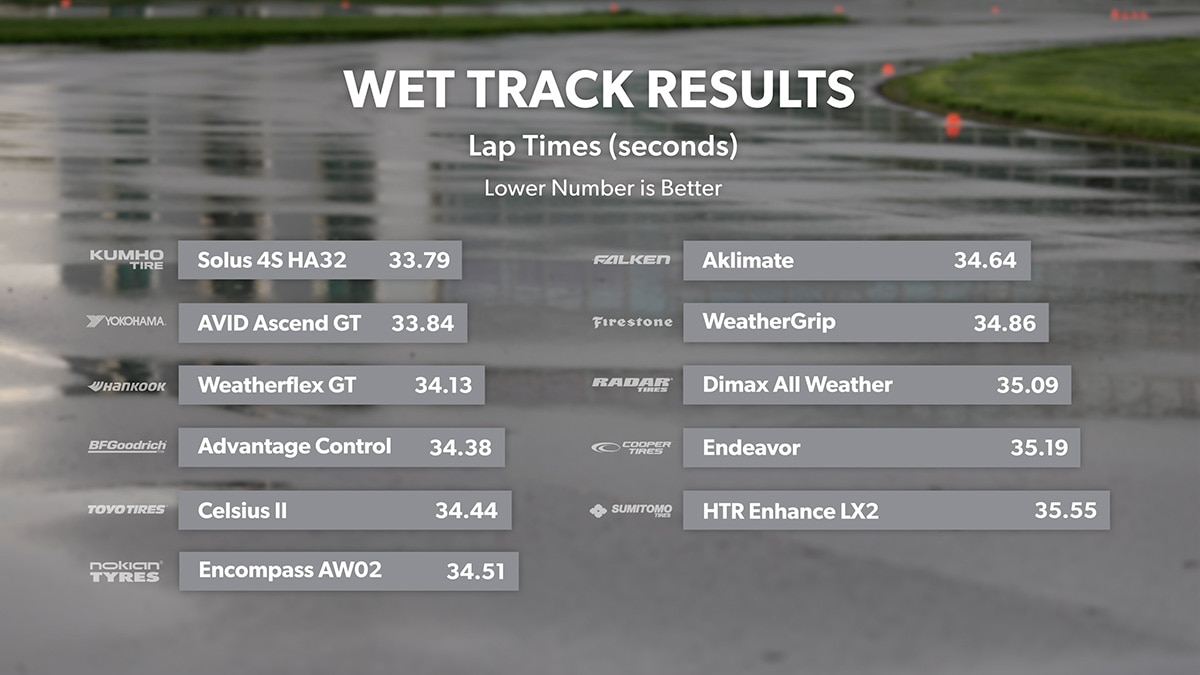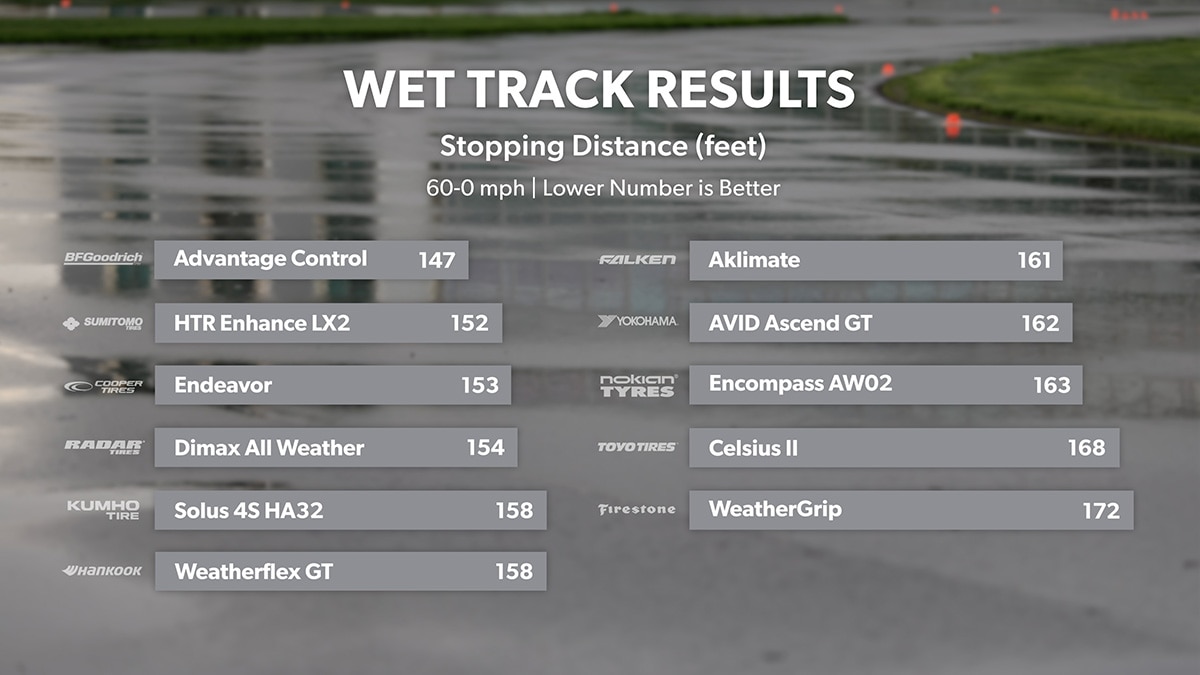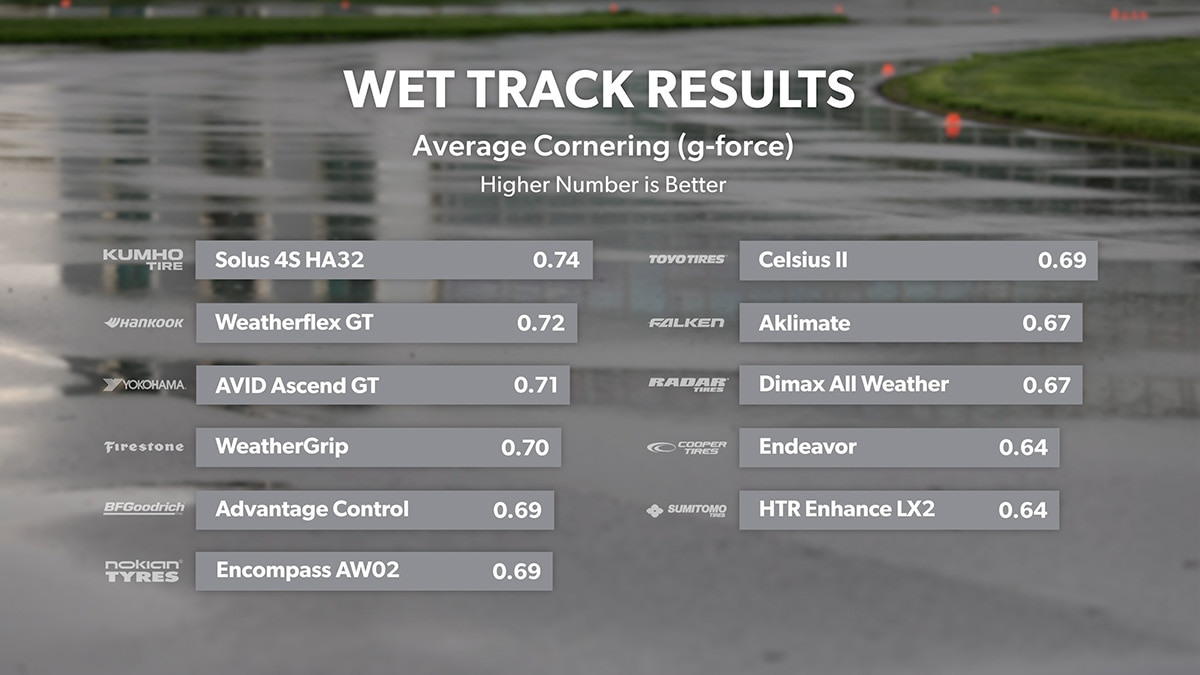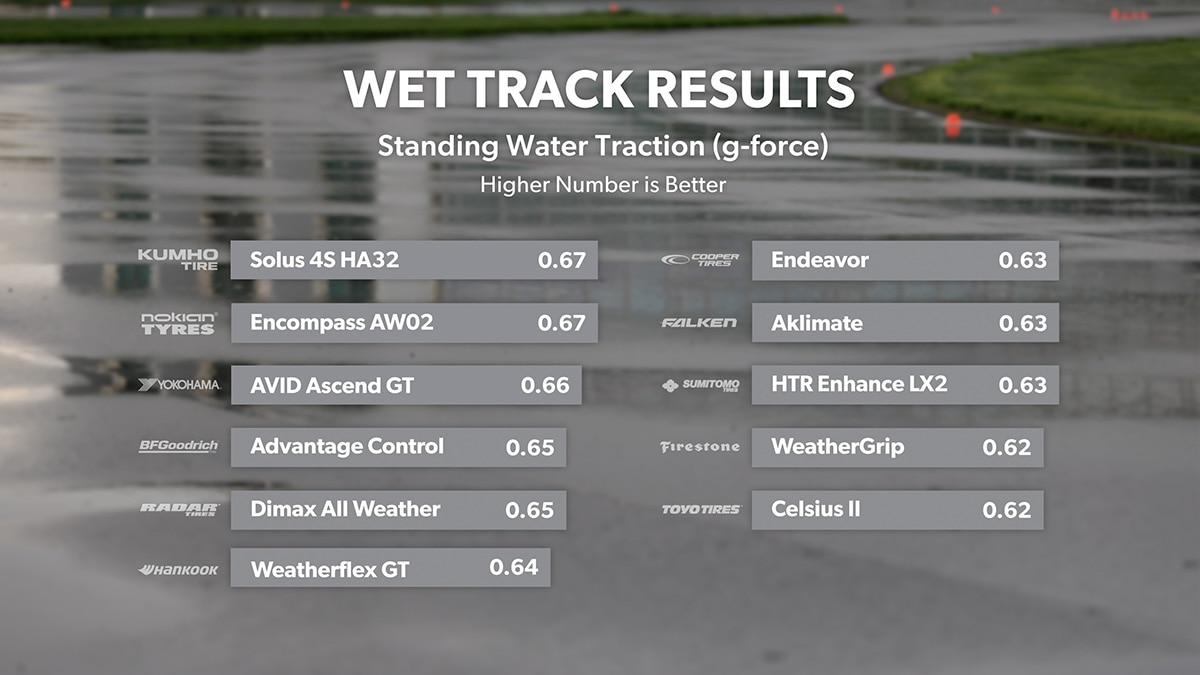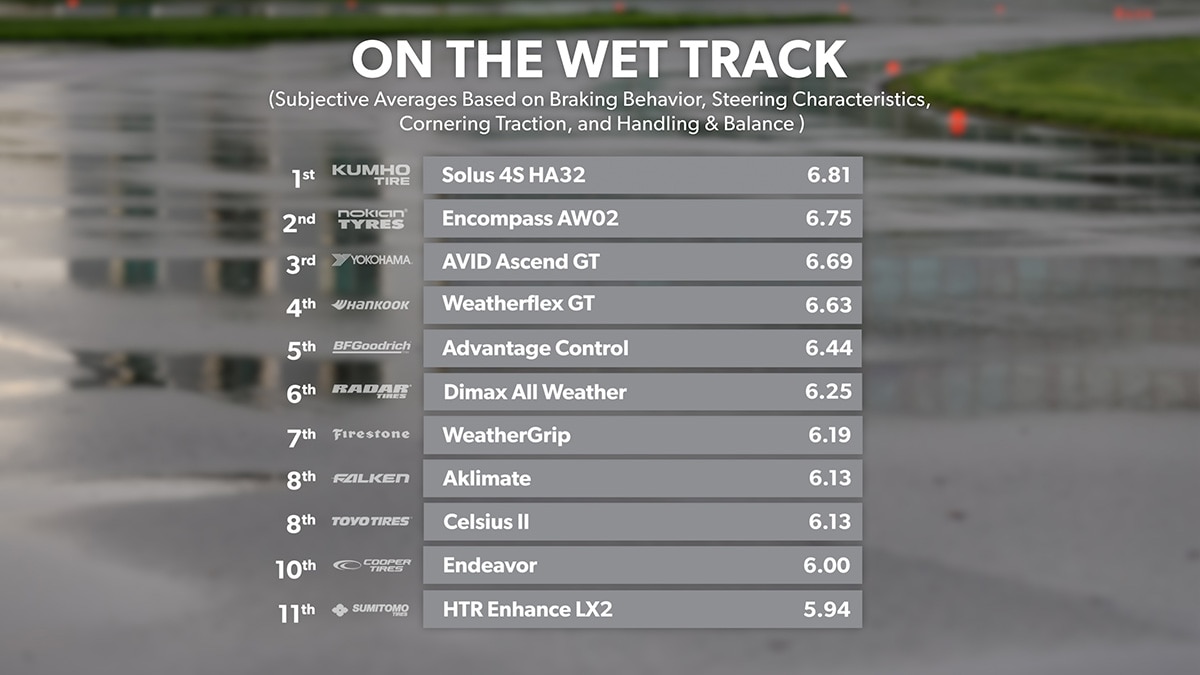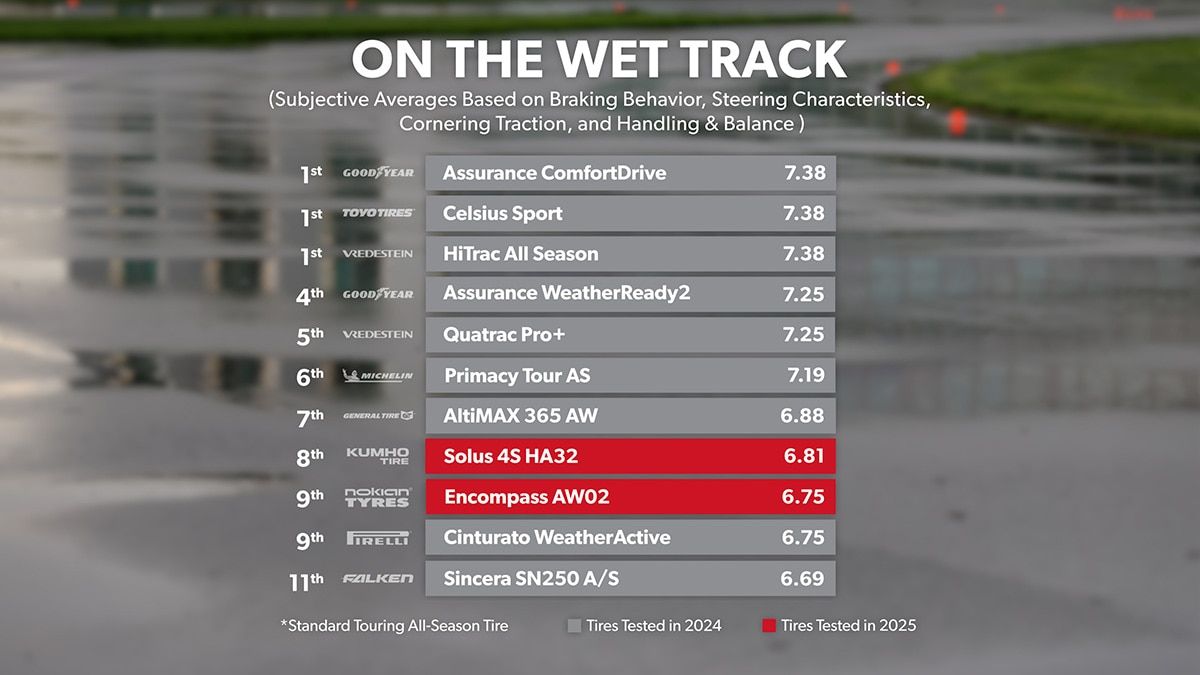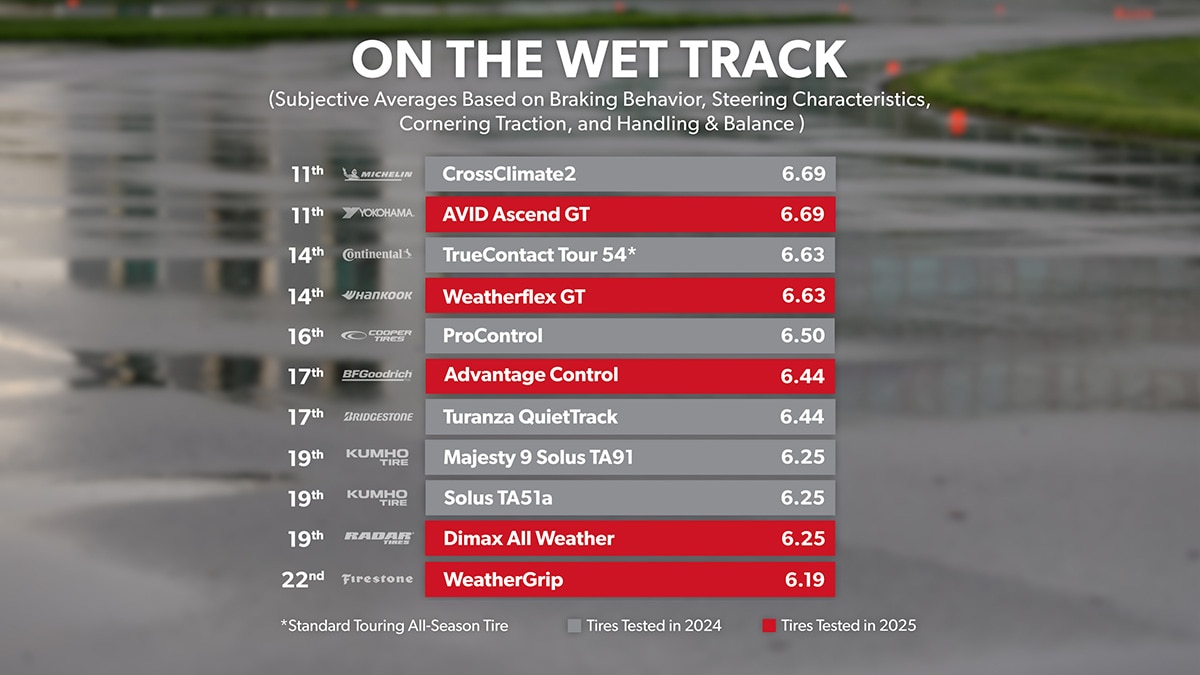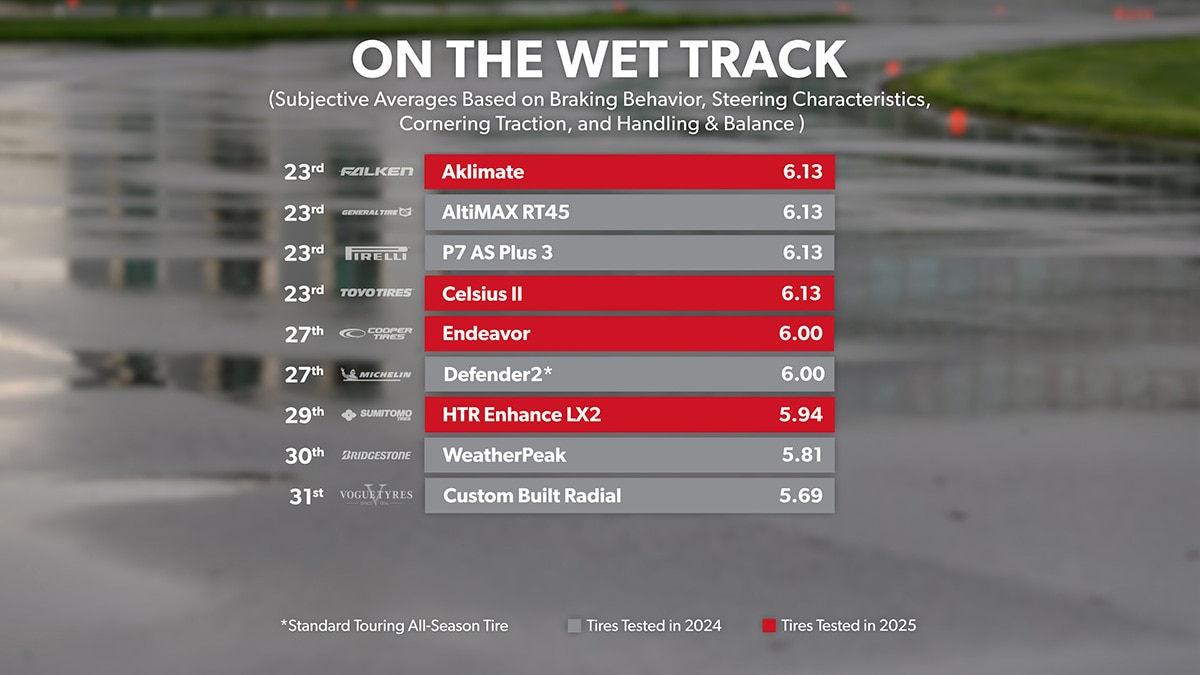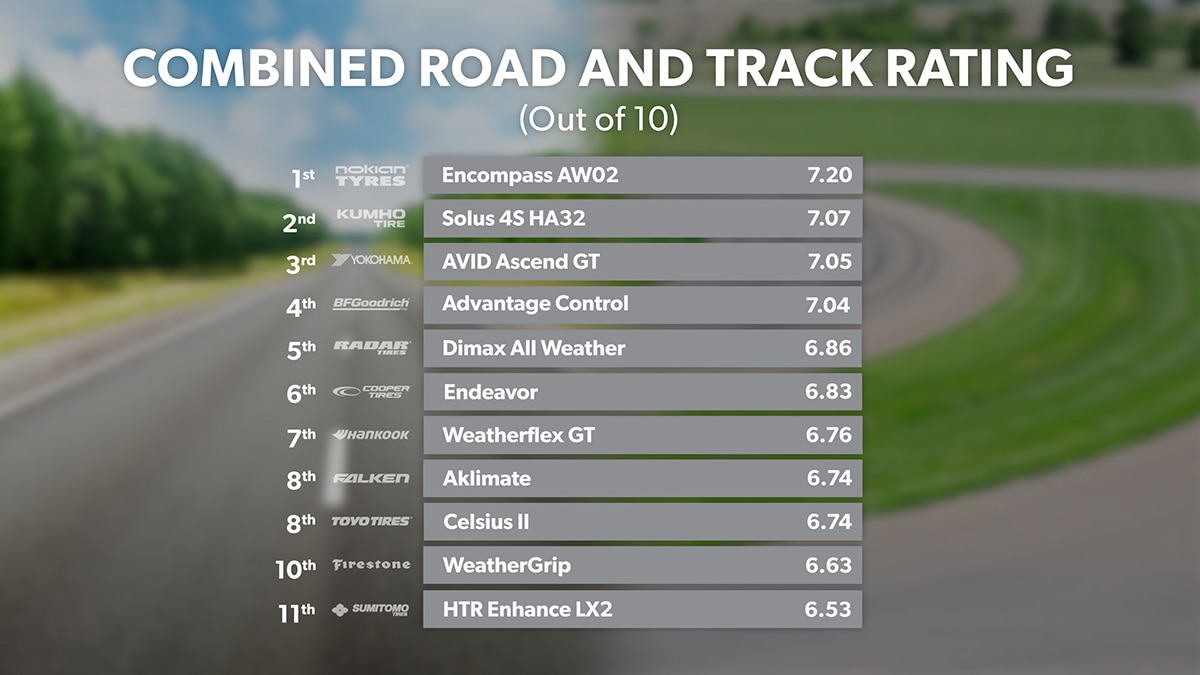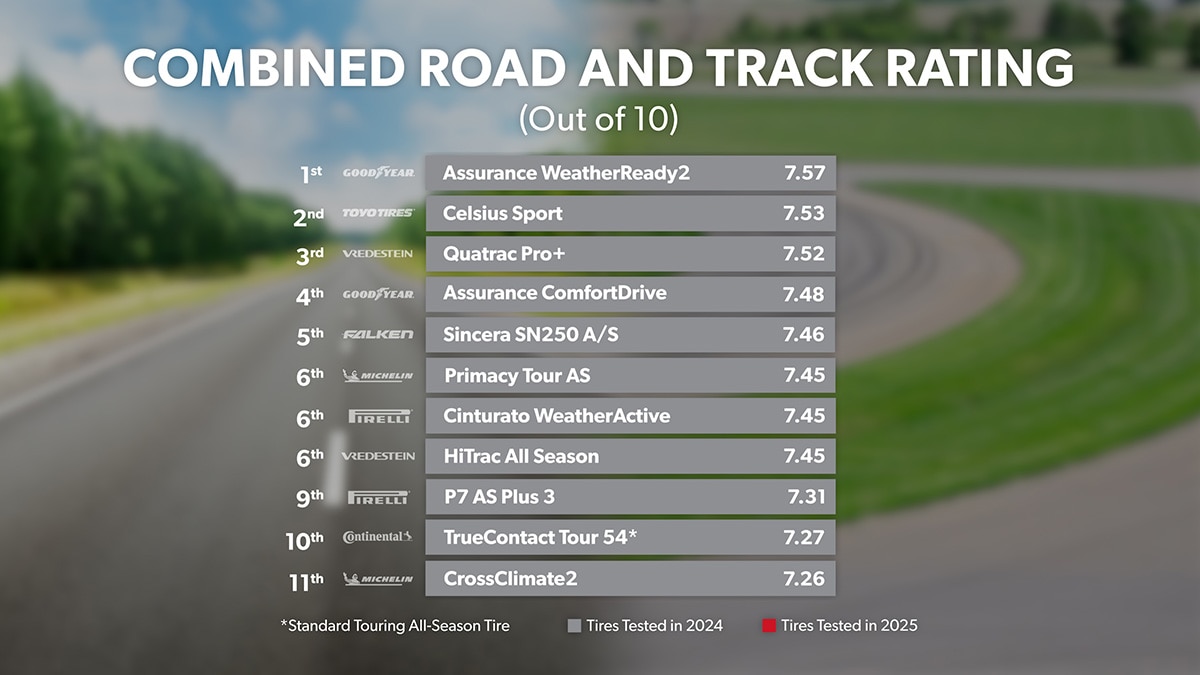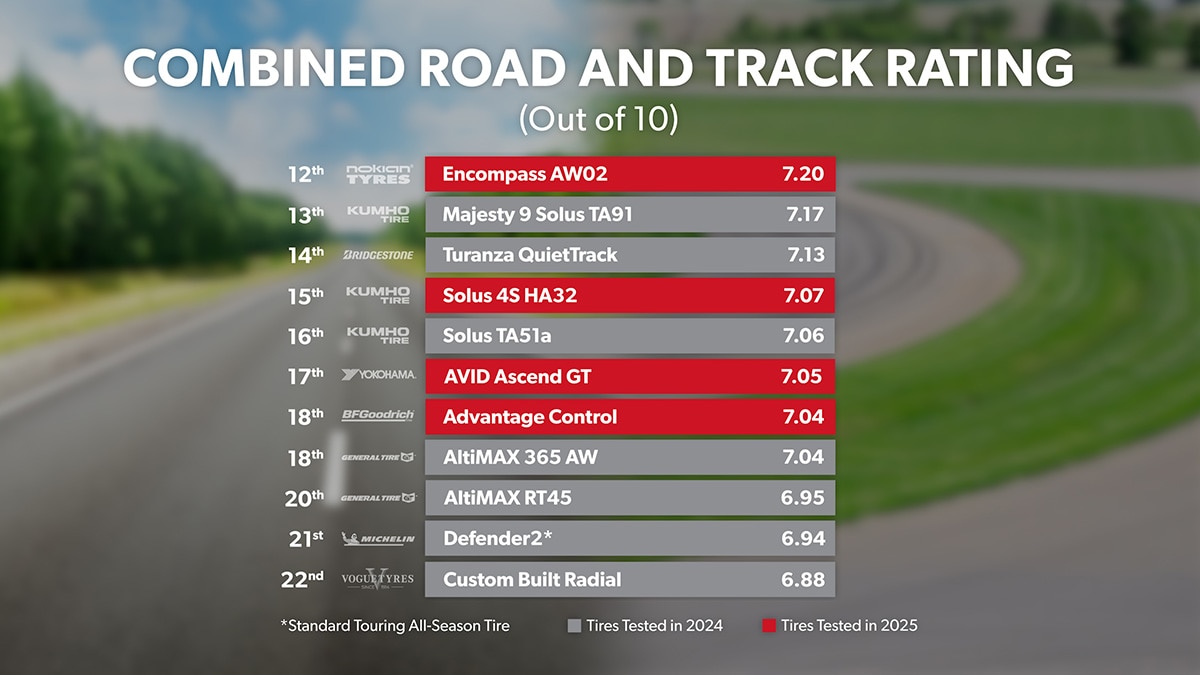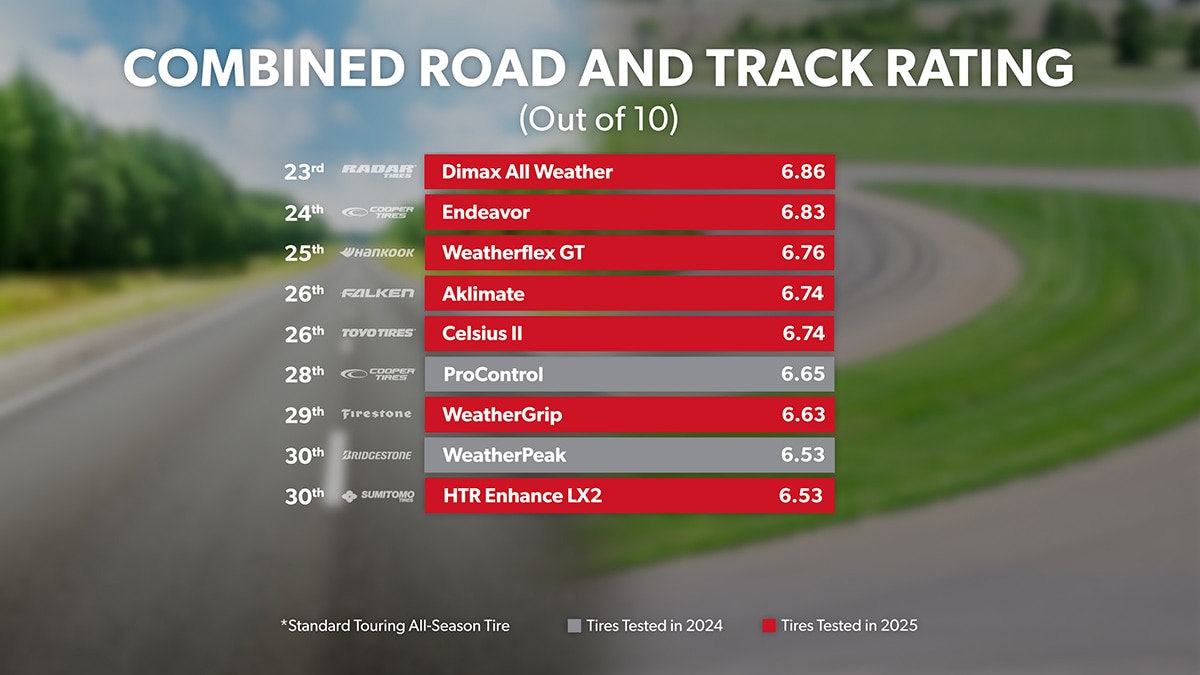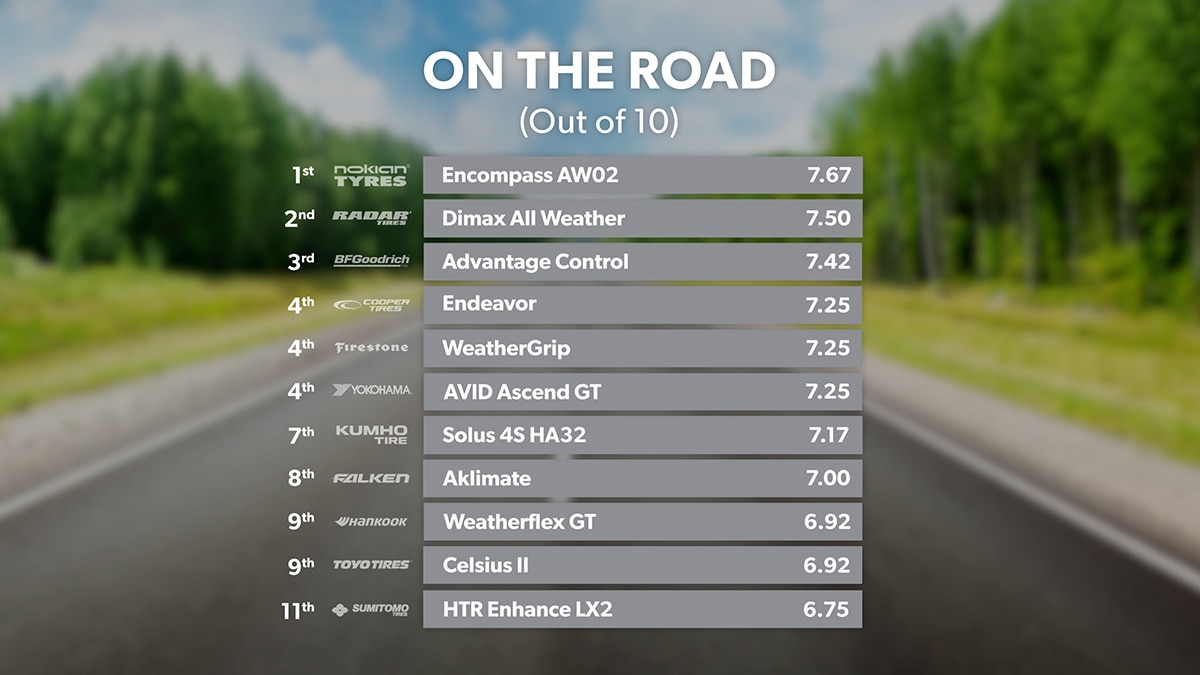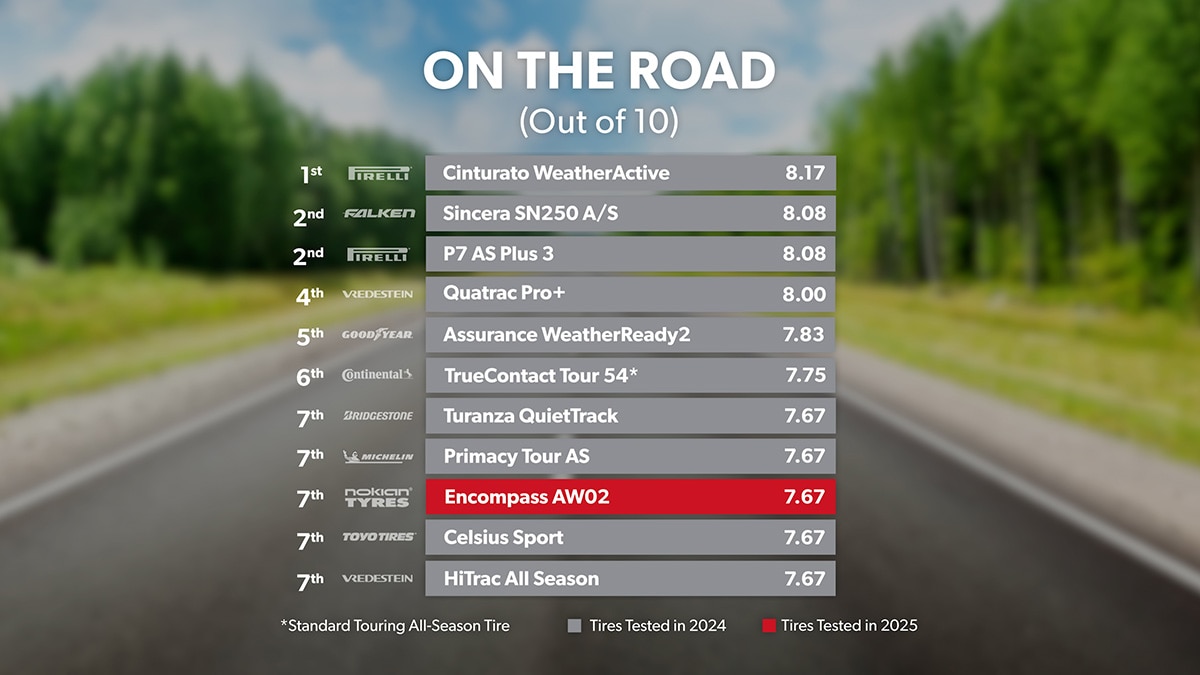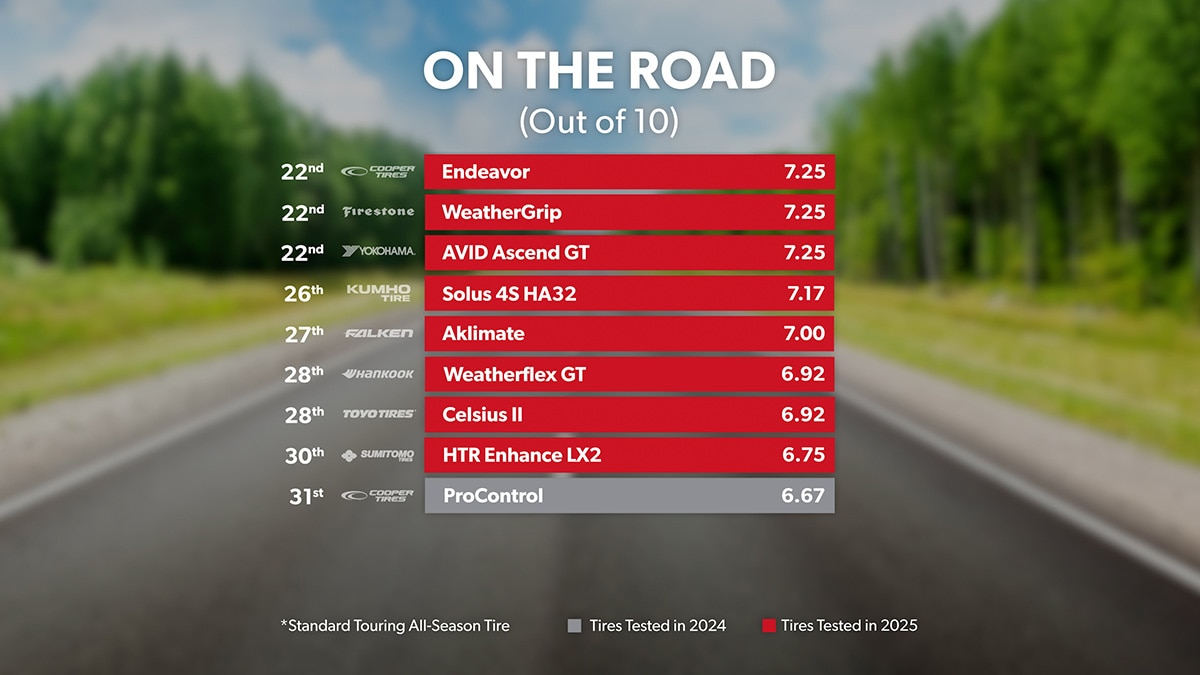Touring tires are about as inevitable as death and taxes - either you're driving on them now, you've got them on your daily commuter, or someone you know who isn't quite as passionate about vehicle dynamics as you are has them installed. You either know the type, or you are the type. "I don't need to go fast. I just want them to last for a long time. I just want to be comfortable." Safe, secure, dependable travelers that are designed to function year-round with little fuss. Just get in and drive.
The funny thing about tires, just like other things in life, is that the more effortless something appears to be, the more work that went into making it seem that way. For a tire to be comfortable, long-lasting, capable of handling emergency maneuvers in the dry, the wet, and the winter, and yet not be too noisy, or give up too much in any one area takes an innumerable amount of small tweaks.
The collection of tires we've gathered here today are not the top-end premium options, but just like their overarching category of Grand Touring All-Season (GTAS), they're the everyday champions that keep you safe, your mom, your friends, your barista, the guy next to you on the highway who probably should stop texting at 83mph. You should slow down, by the way. They are names you know, and maybe some you don't, some are traditional all-season tires, and some are three-peak mountain snowflake branded all weather tires. A few we've tested previously on older platforms, and some are brand new, just hitting the market now. It's a good mix.
We'll introduce each, break down our experiences with them on our real-world road ride, then discuss their traction and subjective behavior on both a wet and dry track to understand how these tires act when pushed to their limits, mimicking the kind of high-speed emergency maneuvers you might need to deal with in a sudden crisis.
In addition to the limit-pushing data and experience we gather from running laps, this test will reference our "Emergency Lane Change" (ELC) maneuver. On the dry track surface, from a target speed of 45 miles per hour, our drivers will pass through 3 sets of cones to illustrate how the tires handle the kind of sudden, reactive swerves a person actually makes in an emergency situation. The 1st set indicates the point a person would react to an obstacle (such as a stopped car or pedestrian) leaving the "lane." The 2nd set is the target placement to avoid the obstacle, indicating the lane change has succeeded. The 3rd set of cones represents the successful target for returning to the "lane." Afterward, we complete a dry lap to get a feel for their behavior, similar to our wet driving, just without a timed component.
BFGoodrich Advantage Control
Just about everyone makes a GTAS tire, and the Advantage Control is BFGoodrich's standard bearer. As a company perhaps best known for their off-road, classic, and performance offerings, they might not be the first option that comes to mind for a daily driver - but they've spent decades nailing the fundamentals in other areas. On our road ride, the Advantage Control was pleasant, softer than a good number of the other tires in the test, but not the most settled, as we experienced a bit of post-impact motion. Noise was well-mixed, higher volume over asphalt surfaces, with higher pitched tones making themselves known on smooth pavement. Steering was fluid and natural, but unhurried.
With a wet surface underneath the tires, the Advantage Control was capable - it wasn't quick, but it felt like it had enough traction to take care of our drivers through hard cornering and aggressive slalom maneuvers. Even combining inputs or giving it a little extra throttle while steering didn't feel as punishing as it could on other specs. It was forgiving to drive, a boon for non-professional drivers handling unexpected conditions. Once the track dried off, the Advantage Control was predictable and stable through the Emergency Lane Change, leading with the front instead of trying to get the rear axle too involved.
Cooper Endeavor
Designed to deliver a practical blend of comfort, handling, and durability - the Endeavor is Cooper's category representative in this test. During our road ride, it felt taut, but smoother and less choppy than others, with good control over big impacts and minimal movement over small ones. Noise levels were acceptable, with cyclical tones and light ringing over tar strips or chip-and-seal surfaces, but nothing that stood out as overly disruptive. Steering, however, emerged as a weak point: vague, imprecise, and lacking the composure or feedback needed to feel natural or confident.
On the wet track, the Endeavor felt eager and responsive, even if its traction couldn't fully support that enthusiasm. Testers found themselves overshooting braking zones and encountering understeer when pushed, especially in transitions like the slalom. While not unmanageable, its wet performance was ultimately just average - certainly usable with disciplined inputs, but less confidence-inspiring when driven aggressively. It was more balanced and composed during the dry Emergency Lane Change however. It responded predictably to steering inputs, with just a little rear end engagement. While it could rotate more than expected, it remained controllable and trustworthy throughout, completing the maneuver every time.
Falken Aklimate
The Aklimate was introduced two years ago by Falken as its all-weather contender in the category space, an attempt to index more toward winter performance without sacrificing on-road comfort or dry/wet performance. The last time we looked at this tire in 2023 on our old BRZ test platform, it seems they'd done just that - it was well-rounded without truly standing out either. This time started off with a fairly similar experience on-road: the ride was comfortable enough, rounding over most impacts well, but with quite a lot of motion afterwards, and without really "settling" over repetitive bumps. A variety of noise was present over all surfaces - everything from a mixed, higher-pitched static on the smoothest, to upper register cavity tones on asphalt. The steering response was a particular highlight: quick, eager, happy to move with little delay.
Once the Aklimate got moving in the wet, it was clear that it had strong capability, it just didn't do the best job at communicating where its limits were. That led to missed timing on corners, not making the most of braking zones, and a generally unrefined feeling. The only major consequence in most cases was that it would push into understeer, a common expectation for the vehicle, and was a bit slower to recover than other tires. Under the limit, traction delivery was reasonably balanced and could accept some combined inputs. Good, but not great. Once the track dried off and we could attempt the Emergency Lane Change, the Aklimate was pretty reliable - it felt solid, eager to change direction, the rear wanted to get involved during the maneuver - outside of a single failed attempt, it was good overall.
Firestone WeatherGrip
Firestone's all-weather tire has been on the market for a few years, to reasonable success with both customers and our testing in the past, but we haven't had the opportunity to check it out on the Camry. The experience was generally comfortable during our road ride - smoothing over small, sharp impacts like tar strips and cracks with a progressive, rounded feel. While it lacked a bit of composure over larger bumps and exhibited elevated, multi-tonal tread noise - particularly on rougher surfaces - it stayed mostly unobtrusive in overall volume. Steering was soft and a bit delayed in its response, offering a rubbery, slow-to-react feel that might fit the touring segment but didn't inspire much confidence or precision.
The same characteristics on the road that made it a little dull to handle translated in a surprisingly fitting way to the wet track - complementing the tire in low-grip conditions. It felt properly mated to the WeatherGrip's traction capabilities. The relaxed demeanor made it easier to find and maintain the limit, resulting in surprisingly strong pace and stability. Though it wasn't sharp or lively, the overall balance and traction proved effective. It never promised more than it could deliver. With a dry surface and the Emergency Lane Change to contend with however, it became clear the WeatherGrip could not deliver. It could not recover quickly enough from the initial input to be ready in time for the secondary part of the move. By the time the front end would bite, the rear was so far behind any hope of catching up evaporated and we were either aborting the run, sideways, or going off course. We never managed to successfully complete the maneuver in this tire.
Hankook Weatherflex GT
A newer Hankook tire, the Weatherflex GT contains a list of the latest technological tire innovations designed to maximize its all-weather performance, making for a strong product in theory. Is it a winning combination, or a paper tiger? During our experience, the ride quality came across as firm and slightly unrefined, with sharper impacts and more noticeable motion over undulations and tar strips. Noise levels were moderate, with a mix of tones and textures that varied by surface but stayed mostly in check. Steering was generally acceptable, not as urgent off-center as other tires, but quick enough - and once it got moving, felt natural, eager to be directed.
The Weatherflex GT was well-rounded and confident on the wet track, offering solid grip, good balance, and clear communication at the limit. Steering response was commendable, and both braking and combined traction felt strong and consistent. While not the strongest in the test by any objective metric, it was composed and predictable throughout - which can be a preferable trait to drivers than more raw, knife-edged performance. The Emergency Lane Change on a dry surface was unfortunately not quite as composed. It did narrowly complete the maneuver every time, the ability was technically there, but in practice it didn't feel quite as planted or confident as most of the other tires in the test. There was a slight lag in response, some mushiness to it that made it feel as if it was catching up just enough to make it through.
Kumho Solus 4S HA32
At a glance, Kumho's Solus 4S HA32 wears its inspiration on its sleeve, clearly paying homage to successful directional Grand Touring All-Season tires. However, performance is often just as much (if not moreso) about what can't be seen: like compound and construction, so ultimately the proof of a successful (or otherwise) design comes from testing. During the road ride, we found the Solus 4S HA32 offered a firm, but largely acceptable ride for a touring product, with sharp impacts and minor aftershocks over features like tar strips. Road noise was present at low speeds and showed a mix of tonal variety, with a bassy hum and slight resonance on rougher surfaces, though it was better controlled at highway speeds. Steering stood out as a strength: light, natural, and intuitive, it felt lively, almost sporty.
That liveliness persisted during our wet testing as well - with impressive traction and a noticeable improvement in grip compared to most of the tires we tested. It felt responsive and precise, allowing for confident placement through slaloms and tight turns. Overall balance was well-managed, and both braking and cornering felt secure and composed. Our experience was again positive on a dry surface during the Emergency Lane Change maneuver. The steering was alert, reactive; it pointed the car where it needed to go, and when we did exceed the tire's limits, it moved predictably into manageable understeer. It was never bad enough to cause a failed attempt, only chatter the front tires a bit, and it passed every time.
Nokian Encompass AW02
The follow-up to Nokian's previous category offering, the Encompass AW01, which indexed so heavily into cold weather performance that it ultimately came at a cost to its other characteristics, this tire has a lot to prove. Thankfully, it started doing so almost immediately on our road ride, delivering a well-rounded touring experience with a taut but comfortable ride that handled both large and small impacts with composure. Noise levels were generally quite good, among the best in the test, with only low-speed whir and minor resonance on rougher surfaces. Steering felt natural and responsive, offering good precision and a cheerful character that made for a pleasant drive all-around.
It was enjoyable on the wet track as well, providing a well-balanced and pleasant drive with responsive steering. We could be a bit rougher with it, get a touch of playful rotation in the rear, and it would catch itself and keep on. Although its overall grip was slightly below the absolute top performers, it was close - and perhaps more importantly - felt predictable and easy to manage, which made it one of the most satisfying to push near the limits in the wet. Unfortunately, it wasn't quite as kind in the dry during Emergency Lane Change attempts. It passed the maneuver every time with our professional drivers, but not exactly in the way we would normally consider a success - it really engaged the rear, and would have only taken a small error or overcorrection to not just fail, but spin. Passing the ELC perpendicular to the direction of travel was not a comforting way of completing the maneuver.
Radar Dimax All Weather
Radar tires are, at the time of writing, one of the newest brands carried by Tire Rack. Prioritizing strong style and value, can they run with some of the most storied names in the business? The Dimax All Weather made a strong initial impression on the road ride - refined, composed, it handled most imperfections and impacts comfortably, in line with the best in the test. It didn't completely eliminate road noise, with tonal variety on the smoothest, quietest surfaces, and a higher-pitched tone exiting the off-ramp at highway speeds, but was generally very well managed. Steering was its main weakness, and even that wasn't particularly bad, just slightly rubbery, a little delay between input and a response. One of the nicest tires we drove on the road in this group.
The Dimax All Weather was not quite as impressive during wet testing. It was good enough, certainly: communicating its limits clearly, with steering that felt well-mated to its traction levels, but neither of those ventured into the territory of the greats. Still, because of that communication and decent traction, we never had any major understeer moments or particularly egregious issues with it either. After the track dried off, Emergency Lane Change attempts showed the Dimax All Weather could clear the maneuver, albeit not easily. In a proper attempt, each part of the move is separate: avoid the obstacle, settle, return the wheel, clear the 2nd cone, return to "lane", clearing the final gate. With the Dimax All Weather, it could still technically complete the move, but it needed to be handled more like a slalom, queuing up actions just slightly beforehand, anticipating the rubberiness of the steering delay. Technically a pass, but not a comfortable one.
Sumitomo HTR Enhance LX2
The Sumitomo HTR Enhance LX2 is another value-oriented all-season touring tire designed to provide year-round performance for everyday driving. Our testers agreed it was fairly soft and comfortable over the length of the road ride - cushioning large impacts with ease and absorbing most smaller impacts with little fuss. Higher speed impacts were more noticeable, however. Road noise was higher volume across most surfaces, but more noticeable on smoother textures, where pattern tones and slight reverberation became apparent. Steering impressions were mixed - ranging from responsive and intuitive to one tester, though less satisfying to another.
The wet track experience on the HTR Enhance LX2 was interesting. In one sense, it was one of the lowest traction tires we tested, with slower laps, longer braking, and a general lack of ability to perform at the level of most of the other tires. However, it was also one of the nicest to drive - it clearly communicated its limits and was easy to stay within them without the abrupt traction fall-off that can be prevalent in higher performing tires. Unfortunately, there's little reward for having lower grip overall, but the well-balanced delivery and steering deserve credit. Its lack of overall ability caught up to the HTR Enhance LX2 once the water was gone and the Emergency Lane Change was up. It managed to complete the maneuver around 75% of the time, with its sluggish traction delivery unable to keep adequate pace with back-to-back inputs, forcing a handful of abandoned runs.
Toyo Celsius II
It's been a couple of years since we evaluated the Celsius II on our old test platform, and it's time to give this all-weather touring option another look on the Toyota Camry to see how it performs. When we took the Celsius II out on the road, ride quality as a whole was just…good. Not too taut, not too soft, it dealt with big impacts well, but there was a lot of excess motion, particularly over small or repetitive impacts. Overall volume of noise was higher compared to its peers over coarse roads or at highway speeds, but mostly unremarkable, with the exception of smooth surfaces that allowed pattern noise to rise to attention. Steering was a little too lively, a little too eager, and never felt truly settled on-center.
On the wet track, the Celsius II delivered a competent and balanced performance. It showed no major flaws but also failed to showcase any real standout qualities. Steering and braking were adequate, and it maintained composure without any bad habits. While it wasn't particularly exciting, when it comes to functioning as a daily driver, that's not a negative. Its predictability and neutrality were appropriate for the category. It was a similar story once the track dried off and we attempted the Emergency Lane Change: just quiet, simple competence. Once again, it wasn't exciting, it didn't feel like a performance tire, it just succeeded in doing what we asked.
Yokohama AVID Ascend GT
The AVID Ascend GT has been a popular all-season value option for years, and while it doesn't have the 3PMSF "all-weather" moniker of the newer tires here, it has also done a fair job holding its own in customer satisfaction. How does it perform on our new Camry though? The road ride brought us a composed and well-damped experience, offering a controlled balance between firmness and comfort. Larger impacts were concise but not overly harsh, though smaller bumps and cracks came through with noticeable sharpness, especially compared to softer touring options. Noise levels were moderate; while some tread and tonal noise stood out, it generally avoided any harsh or offensive sounds. Steering was appropriate for the category, offering predictable response to input, without being too lively or too dull.
Once on the wet track, the AVID Ascend GT delivered strong wet performance with predictable and balanced handling, making it very easy to control and position. It felt comfortable and composed, with dynamics comparable to the stronger performers in the group. Braking was mostly solid, though one tester noted a slight drop in confidence under harder stops compared to the tire's otherwise strong grip. The Emergency Lane Change was equally inspiring. The AVID Ascend GT cleared it with no issues; it was easy to handle, easy to correct any overexuberant moves, each step was urgent, firm, a solid foundation.
Summary Conclusion
Just like we stated in the introduction - there's a wide variety of Grand Touring All-Season tires, and balancing all their characteristics is a massive ask. As the trend moves increasingly toward an "all-weather" focus for this category, can tire manufacturers manage to walk the line between maintaining wet/dry and winter performance with a ride that's comfortable enough that consumers want to drive on them every day? The results today seem to indicate that they can manage it, but traditional all-season (non-3PMSF branded) tires are clearly still worth consideration as well. None of these tires were just a flat-out "best at everything", nor were any of them truly disastrous. The spread in performance between the entire group was relatively narrow. Their individual strengths and weaknesses should be kept in mind when finding the right fit for your situation.
Nokian's Encompass AW02 deserves its praise this test, not just for improving drastically over its predecessor, but for standing on its own as a worthy consideration for the category. It displayed truly notable on-road comfort alongside strong wet performance. It isn't perfect, and we'd like to see a touch of its wildness tamed in the dry, but it has earned its place among the best in the test. Kumho's Solus 4S HA32 is an interesting counter to the Nokian; it wasn't the quietest tire on the road, although it was still quite nice to drive overall, but it was handily our top performer in both the dry and wet among this group. Meanwhile, Yokohama's AVID Ascend GT was quietly accomplished at everything we asked of it. It wasn't the strongest in any one respect, but it avoided any serious pitfalls or weaknesses. Particularly in this category, that's a real strength on its own. It was a very similar story with BFGoodrich's Advantage Control, it was just a little softer on the road comparatively, while not being quite as capable in wet/dry conditions, though it was a narrow gap between the two in both cases.
We swing very radically in the other direction for Radar's Dimax All Weather. It was one of our favorite tires in the test during the road ride, but it was held back by its tricky dry handling, and merely acceptable wet aptitude. The ELC maneuver was an uncomfortable mess though, and there's no dancing around it. Cooper's Endeavor might have joined the ranks of the "well-rounded but not exceptional" had it not been for its lackluster ability to handle wet pavement, and Hankook's Weatherflex GT made the opposite play, with fairly strong wet performance among the group, even if it was just average when it came to delivering on a quiet ride and strong dry dynamic ability. Falken's Aklimate provided a balanced experience overall, just at a step down from the group as a whole. Toyo's Celsius II handled the dry lane change well, it handled most things well - but didn't stand out in the wet or the road. It was simply fine.
Finally, our last couple of tires share in the distinction of being pleasant enough - just with one or two caveats that prevent them from ascending to higher status. Firestone's WeatherGrip provided our drivers with a composed, comfortable drive and reasonable behavior on the wet track, but it just could not complete the Emergency Lane Change reliably. Sumitomo's HTR Enhance LX2 had a higher (though not perfect) success rate on the ELC, strong straight-line braking, drove well in the wet and offered nice cushioning on the road, but its lower traction limits and noisier ride did it no favors among a tightly competitive set.

